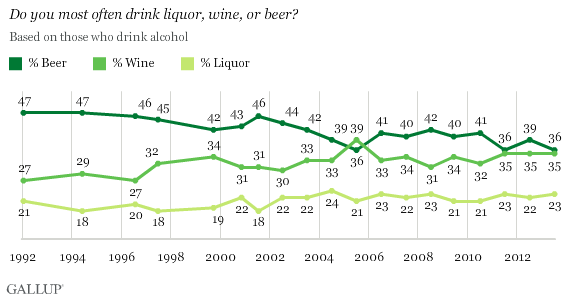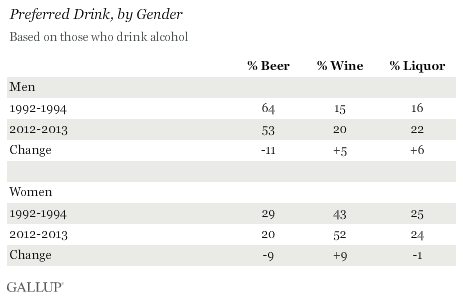PRINCETON, NJ -- Americans who drink alcohol are about equally likely to say they drink beer (36%) or wine (35%) most often. Another 23% say liquor is their beverage of choice. That continues the trend in which beer has declined as the preferred beverage of U.S. drinkers, shrinking its advantage over wine from 20 percentage points in 1992 to one point today.

The results are based on Gallup's annual Consumption Habits poll, conducted July 10-14. The poll finds 60% of Americans saying they drink alcohol at least occasionally, in line with the historical average of 63% since 1939.
Young adult drinkers' alcoholic beverage preferences have changed dramatically over the past two decades. In the early 1990s, 71% of adults under age 30 said they drank beer most often; now it is 41% among that age group. There has been a much smaller decline in the percentage of 30- to 49-year-olds who say they drink beer the most, from 48% to 43%, with essentially no change in older drinkers' beer preference.
Younger adults' preferences have shifted toward both liquor and wine, but more so toward liquor, over the past two decades. Those between the ages of 30 and 49 have moved exclusively toward liquor. Older Americans now increasingly say they drink wine most and are less likely to say they drink liquor most.

Despite these changes, beer remains the preferred beverage of 18- to 29- and 30- to 49-year-olds. Wine continues to rank as the top choice of those 50 and older.
Nonwhites More Likely Than Whites to Shift Preference Away From Beer
Since the early 1990s, both whites and nonwhites have become less likely to choose beer as their favorite alcoholic drink. However, nonwhites have shown a greater shift than whites, down 19 points and nine points, respectively. Both racial groups' preferences for wine have increased, with smaller gains in both groups' preferences for liquor.

As a result of these shifts, beer and wine are now tied as the favorite drink of whites and nonwhites.
Major Gender Divide in Preferred Beverage
Gallup has consistently found a wide gender difference in preferred alcoholic beverage, going back to the initial asking of the question in 1992. Currently, 53% of men name beer as their favorite drink, while 22% say liquor and 20% wine. Among women, 52% say they drink wine most often, while 24% say liquor and 20% beer.
Despite males' continued allegiance to beer, the percentage of men who say it is their favorite drink has declined significantly, down 11 points since the early 1990s, with roughly equal increases since then in the percentages of men preferring wine and liquor.
Meanwhile, women's preference for wine is wider today than in the past, with most of the increase coming at the expense of beer.

In addition to the trends on beverage preference, the Consumption Poll also finds:
- Americans who drink generally do so on a semi-frequent basis. Thirty-five percent report having had a drink in the last 24 hours and another 29% in the past week. Those figures are in line with recent surveys, although Americans' reported frequency of drinking is higher now than it was in the 1990s.
- Beer drinkers are slightly more likely to say they have had a drink more recently -- 71% report having had a drink in the past week, compared with 63% of wine drinkers and 55% of liquor drinkers.
- Drinkers on average report consuming 3.8 alcoholic drinks in the past week. The average has generally been around four drinks the past few years, but has been closer to five in select years, including 2003, 2007, and 2009.
- Twenty-one percent of drinkers say they sometimes drink more than they should. This percentage has been fairly consistent over time, ranging between 17% and 25% over the past decade. The historical high point was 35% in 1989.
- Twenty-nine percent of all Americans say drinking has been a cause of trouble in their family, essentially unchanged across four Gallup measurements since 2008. The percentage saying drinking has caused trouble peaked at 37% in 2004.
Implications
Although the percentage of Americans who drink alcohol has stayed fairly steady in the 60% range since the early 1990s, U.S. drinkers' preferences have shifted to the point that drinkers are now just as likely to say they drink wine most often as to say beer.
Most key subgroups have shifted away from beer as their favorite alcoholic beverage, but this trend is particularly pronounced among younger Americans and minorities. These demographic patterns, should they persist, suggest that beer may not return to its position from two decades ago as the dominant preferred alcoholic beverage.
Yet beer still ranks as the preferred beverage among young adults and is tied with wine among minorities, so unless wine or liquor eclipses beer as the favorite alcoholic drink among these groups, it doesn't appear that beer's position will grow much weaker in the coming years.
Survey Methods
Results for this Gallup poll are based on telephone interviews conducted July 10-14, 2013, with a random sample of 2,027 adults, aged 18 and older, living in all 50 U.S. states and the District of Columbia.
For results based on the total sample of national adults, one can say with 95% confidence that the margin of sampling error is ±3 percentage points.
For results based on the total sample of 1,259 drinkers, one can say with 95% confidence that the margin of sampling error is ±3 percentage points.
Interviews are conducted with respondents on landline telephones and cellular phones, with interviews conducted in Spanish for respondents who are primarily Spanish-speaking. Each sample of national adults includes a minimum quota of 50% cellphone respondents and 50% landline respondents, with additional minimum quotas by region. Landline and cell telephone numbers are selected using random-digit-dial methods. Landline respondents are chosen at random within each household on the basis of which member had the most recent birthday.
Samples are weighted to correct for unequal selection probability, nonresponse, and double coverage of landline and cell users in the two sampling frames. They are also weighted to match the national demographics of gender, age, race, Hispanic ethnicity, education, region, population density, and phone status (cellphone only/landline only/both, and cellphone mostly). Demographic weighting targets are based on the March 2012 Current Population Survey figures for the aged 18 and older U.S. population. Phone status targets are based on the July-December 2011 National Health Interview Survey. Population density targets are based on the 2010 census. All reported margins of sampling error include the computed design effects for weighting.
In addition to sampling error, question wording and practical difficulties in conducting surveys can introduce error or bias into the findings of public opinion polls.
View methodology, full question results, and trend data.
For more details on Gallup's polling methodology, visit www.gallup.com.
